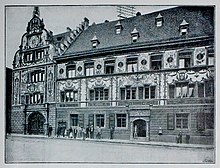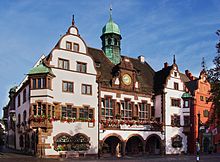User:OberMegaTrans/Rathaus (Freiburg im Breisgau)/Town Hall (Freiburg im Breisgau)

The town hall in Freiburg im Breisgau is spread over a total of 16 locations. The three most important buildings are the Old Town Hall and theNew Town Hall in the city center as well as the Technical Town Hall in the Stühlinger district. The oldest town hall in Freiburg is part of the building complex of the Old Town Hall. It is located in the inner courtyard and is now called Gerichtslaube ("court house") and is directly connected to the Old Town Hall. A passage from the New Town Hall to the Old Town Hall spans the Turmstraße between the two buildings. The three town halls form a complex, in which the three individual buildings are registered as monuments in the list of monuments of the country. [1]
Old Town Hall (Altes Rathaus)
[edit]


At the beginning of the 14th century, the city of Freiburg already bought a building on Franziskanerplatz, today Rathausplatz, followed by two more adjoining buildings to establish the chancery of the town clerk. In the court documents from the years 1443 to 1479 a Richthaus ("court house") is mentioned, which was situated in these buildings. In 1557, master builder Dietrich Neeb and master mason Barthlin Ress were assigned by the council to build a new building on the property. This new building was extended in 1561 to the north by a building, followed in 1600 by another in the Turmstraße. Even though the buildings are united by a uniform facade, it is possible to distinguish between different construction phases.
The building of 1557/1559 has an asymmetrical arrangement of the construction axes, which is still visible today. The ground floor has three entrances. The main portal on the right in the Renaissance style dates back to 1558. Two lions hold the coat of arms of Freiburg and the Bindenschild of Austria. On the far left, the former passage route framed by a Renaissance arch into the courtyard of the town hall serves as the main entrance to the building. Above the arch is a clock crowned by the Double-headed eagle of the Holy Roman Empire with the coats of arms of Hungary and Bohemia as well as under the Herzschild of Austria and Castile. More coats of arms on the gable over the main entrance remind of the different monarchs in Freiburg: The space in the top right contains the red eagle of the House of Zähringen (1091-1218). Next to it there is the lion of the counts of Urach, who took over the eagle of the Zähringer as well when they were counts of Freiburg. In the middle on the left there is the State coat of arms of the Habsburg hereditary lands, the so-called Lerchenwappen, which features five eagles on a blue background that stand for five different duchies. The Habsburgs ruled in Freiburg from 1368 to 1806 (except for 1677 until 1697, when Freiburg was part of the Kingdom of France), which is symbolized by the Alsatian coat of arms in the middle on the right. At the lower left the shield of the House of Austria can be seen, to the right of it there is the coat of arms of Freiburg, the Saint George's Cross.
The house facade of the old town hall was painted with scenes from a dance of death in 1559. At the behest of the council, the painter Galienus Entringer had to replace his own painting with a history painting with scenes from the life of Philip II of Macedon in 1560.[2][3] In 1881, Fritz Geiges replaced the neo-Gothic architectural painting of Simon Gösers of 1810 with paintings in the manner of the Renaissance, but those had to be revised in 1886 because of damage. Today, the building is plastered uniformly in sandstone red. The windows are framed in black andtalisat]); Hans Georg Wehrens: Der Totentanz im alemannischen Sprachraum. "Muos ich doch dran - und weis nit wan". Schnell & Steiner, Regensburg 2012, ISBN 978-3-7954-2563-0, p. 172.< gold with colorful portals.[3]
During Operation Tigerfish in 1944, the old town hall burned out completely and the entire interior decor was lost. Modern materials were used in the reconstruction of the building. The Old Town Hall was also extended by 3 wings in the plain functional style usual for that time. As a result of the new construction, only the nuns' undercroft of the convent of Poor Clares was preserved. This convent was housed in the former Regelhaus (a quasi-monastic building) Zum Lämmlein from 1672 until its abolition in 1782. After that, the buildings were used by the "Hospital of the Holy Spirit".[3]
New Town Hall (Neues Rathaus)
[edit]

The origins of the New Town Hall can be traced back to a duplex house. The one on the right (Zum Rechen) was commissioned by the physician Joachim Schiller von Herdern and built between 1539 and 1545.[4] The university bought the adjacent house (Zum Phönix) and turned both houses into a complex of buildings.
As assembly between the buildings a prestigious columned doorway decorated with pediments carrying the inscription Academia friburgensis had been chosen. This complex of buildings has served the university until 1774 as Collegium Universititas. After the abolishment of the Jesuit order, the university received new collegiate buildings in the Bertoldstraße. The administration department and three of four faculties (medicine not included) relocated there. Since then, the building was called Alte Universität ("Old University"), Altes Kollegium ("Old College") or Alte Anatomie ("Old Anatomy"). In 1867, the Faculty of Medicine moved to new buildings northwards where a new university quarter arised. In the early 18th century, the Auditorium maximum (the biggest lecture hall) had been created in the course of a renovation of the building's south wing. Due to its grand stucco ceiling, the auditorium is considered the most beautiful room in Freiburg which has been created during the baroque period. In 1779, another auditorium for anatomical lectures (Theatrum Anatomicum) had been created in the northern part of the building.
After more than 300 years belonging to the university, the town purchased the building for 140 gold mark and finished it's conversion into the New Town Hall in 1901. Reasons for this include lack of space and the historic preservation of a monument.[5] In addition to that, the town wanted to prevent the demolition of the building and therefore real estate speculation. The transformation into the town hall was also linked to many changes to he substance of the building. A bay window-figure was frequently damaged by trucks and has been fully replaced in 2012.[6]
Today, different theatrical performances take place in the courtyard of the new town hall in summer.
Gerichtslaube
[edit]

The Gerichtslaube ("court house") is the oldest town hall in Freiburg. It is first documented in 1328 as a council building, but only since the 16th century identified as Gerichtslaube.
The Gerichtslaube was destroyed in the air raid on Freiburg (Operation Tigerfish) of 1944 almost to the foundations, it remained only parts of the access staircase and the west wall, the annex which contained the archives, including the establishment of 1553 remained almost intact.[3] From 1961, the reconstruction was run by the Kuratorium Gerichtslaube, a civic initiative and in March 1975, the reconstruction could be started according to the plans of the architect Gregor Schroeder.[3] After the topping out ceremony in December 1975, it was solemnly inaugurated in June 1979.
Another special feature is also here: on August 24, 1498 King Maximilian I had issued at the Freiburg Reichstag a wine Reinheitsgebot (Purity Law), which is older than the well-known purity law for beer from April 23, 1516.
References
[edit]- ^ City archive Freiburg: Verzeichnis der Baudenkmäler der Stadt Freiburg
- ^ Hans Rott: Quellen und Forschungen zur südwestdeutschen und schweizerischen Kunstgeschichte im XV. und XVI. Jahrhundert. Band 3, 1. Stuttgart 1936, p. 111 (Ratsprotokolle, Digi
- ^ a b c d e Peter Kalchthaler: Die historischen Rathäuser. Presse-und Informationsamt, Freiburg im Breisgau 1990.
- ^ Rolf Wilhelm Brednich: Zur Volkskunde des Landkreises in: Landkreis Breisgau-Hochschwarzwald (Hrsg.): Breisgau-Hochschwarzwald. Land vom Rhein über den Schwarzwald zur Baar, Karl Schillinger, Freiburg im Breisgau 1980, ISBN 3-921340-44-6, p. 175.
- ^ Die Alte Universität, Peter Kalchthaler, Badische Zeitung, 2011-08-15, Retrieved 2012-06-25
- ^ Face-Lifting am Rathaus statt Nasenkorrektur, Simone Lutz, Badische Zeitung, 2012-10-20, Retrieved 2012-10-22
Literature
[edit]- Rudolf Thoma: Das alte Rathhaus und die Universität. In: Badischer Architecten- und Ingenieur-Verein, Oberrheinischer Bezirk (ed.): Freiburg im Breisgau. Die Stadt und ihre Bauten. H. M. Poppen & Sohn, Freiburg im Breisgau 1898, p. 449–466
- Berent Schwineköper: Gerichtslaube und Rathaus zu Freiburg. Eine quellenkritische Untersuchung zu Grundfragen der Freiburger Topographie. In: Schau-ins-Land 83, 1965, p. 5–69 (Digitalisat).
- Peter Kalchthaler: Die historischen Rathäuser. Press office, Freiburg im Breisgau 1990.
Weblinks
[edit]- Old Town Hall City of Freiburg
- New Town Hall City of Freiburg
- Technical Town Hall Badische Seiten
- Old Town Hall Badische Seiten
- New Town Hall Badische Seiten
- Gerichtslaube Badische Seiten
Minster
Category:Tourist attractions in Freiburg im Breisgau
Category:Freiburg (region)
Category:University towns in Germany
Category:1120 establishments in the Holy Roman Empire
